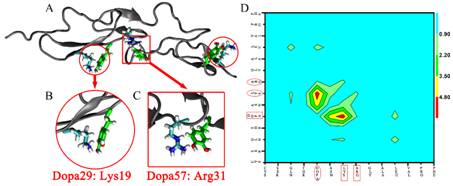Editor: 周婷 Time: 2020-09-08 Number of visits: 175
Xinwen Ou, Bin Xue, Yichong Lao, Yanee Wutthinitikornkit, Ranran Tian, Aodong Zou, Lingyun Yang, Wei Wang, Yi Cao and Jingyuan Li
Mussels can strongly adhere to hydrophilic minerals in sea habitats by secreting adhesive proteins. The adhesion ability of these proteins is often attributed to the presence of Dopa derived from posttranslational modification of Tyr, whereas the contribution of structural feature is overlooked. It remains largely unknown how adhesive proteins overcome the surface-bound water layer to establish underwater adhesion. Here, we use molecular dynamics simulations to probe the conformations of adhesive protein Pvfp-5β and its salt-tolerant underwater adhesion on superhydrophilic mica. Dopa and positively charged basic residues form pairs, in this intrinsically disordered protein, and these residue pairs can lead to firm surface binding. Our simulations further suggest that the unmodified Tyr shows similar functions on surface adhesion by forming pairing structure with a positively charged residue. We confirm the presence of these residue pairs and verify the strong binding ability of unmodified proteins using nuclear magnetic resonance spectroscopy and lap shear tests.

Science Advances 25 Sep 2020: Vol. 6, no. 39, eabb7620
The published article is available at https://advances.sciencemag.org/content/6/39/eabb7620

Add: No. 8 Hainayuan Building, Zijingang Campus, Zhejiang University, 866 Yuhangtang Rd, Hangzhou, 310027, P.R. China
Tel: +86-571-87953325
Fax: +86-571-87951895
Email: yongyi@zju.edu.cn